Intimate Wipes Market
Intimate Wipes Market Size and Share Forecast Outlook 2025 to 2035
The intimate wipes market is projected to grow from USD 920.0 million in 2025 to USD 1,375.0 million by 2035, at a CAGR of 4.1%. Women will dominate with a 63.0% market share, while spunlace will lead the material type segment with a 72.0% share.
Intimate Wipes Market Forecast and Outlook 2025 to 2035
The intimate wipes market stands at the threshold of a decade-long expansion trajectory that promises to reshape personal hygiene technology and feminine care solutions. The market's journey from USD 920.0 million in 2025 to USD 1,370.0 million by 2035 represents substantial growth, the market will rise at a CAGR of 4.1% which demonstrating the accelerating adoption of advanced intimate hygiene products and personal care optimization across consumer segments, retail channels, and global hygiene markets.
The first half of the decade (2025-2030) will witness the market climbing from USD 920.0 million to approximately USD 1,120.0 million, adding USD 200.0 million in value, which constitutes 44% of the total forecast growth period. This phase will be characterized by the rapid adoption of premium intimate wipes, driven by increasing hygiene awareness and the growing need for convenient personal care solutions worldwide. Enhanced product formulations and specialized feminine care features will become standard expectations rather than premium options.
The latter half (2030-2035) will witness continued growth from USD 1,120.0 million to USD 1,370.0 million, representing an addition of USD 250.0 million or 56% of the decade's expansion. This period will be defined by mass market penetration of organic and natural intimate wipes, integration with comprehensive feminine care platforms, and seamless compatibility with existing personal care routines.
The market trajectory signals fundamental shifts in how consumers approach intimate hygiene optimization and personal care management, with participants positioned to benefit from growing demand across multiple product categories and demographic segments.
Quick Stats for Intimate Wipes Market
- Intimate Wipes Market Value (2025): USD 920.0 million
- Intimate Wipes Market Forecast Value (2035): USD 1,370.0 million
- Intimate Wipes Market Forecast CAGR: 4.1%
- Leading Consumer Segment in Intimate Wipes Market: Women
- Key Growth Regions in Intimate Wipes Market: North America, Western Europe, and East Asia
- Top Key Players in Intimate Wipes Market: Kimberly-Clark, P&G, Edgewell, Essity, Unicharm
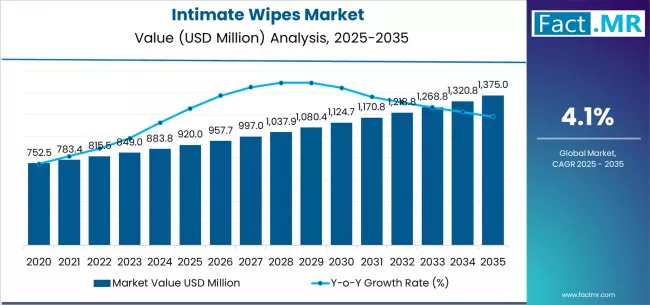
| Period | Primary Revenue Buckets | Share | Notes |
|---|---|---|---|
| Today | Women's intimate wipes | 63% | Traditional feminine hygiene focus |
| Men's personal care wipes | 24% | Growing male grooming segment | |
| Unisex/teen products | 13% | Emerging demographic targeting | |
| Spunlace material products | 72% | Standard material technology | |
| Future (3-5 yrs) | Premium women's formulations | 65-70% | Advanced pH-balanced and organic options |
| Men's grooming expansion | 25-30% | Male-specific marketing and products | |
| Teen/young adult targeting | 15-20% | Educational campaigns and accessibility | |
| Sustainable materials | 25-30% | Biodegradable and eco-friendly options | |
| Online direct-to-consumer | 45-50% | Subscription services and privacy-focused sales |
Intimate Wipes Market Key Takeaways
At-a-Glance Metrics
| Metric | Value |
|---|---|
| Market Value (2025) → | USD 920.0 million |
| Market Forecast (2035) ↑ | USD 1,370.0 million |
| Growth Rate ★ | 4.1% CAGR |
| Leading Consumer Segment → | Women |
| Primary Material Type → | Spunlace |
The market demonstrates strong fundamentals with women's intimate wipes capturing a dominant 63% share through specialized feminine hygiene capabilities and personal care optimization. Spunlace material products drive primary demand at 72%, supported by superior softness characteristics and consumer preference for gentle intimate care. Geographic expansion remains concentrated in developed markets with established personal care infrastructure, while emerging economies show accelerating adoption rates driven by hygiene awareness campaigns and rising disposable income levels.
Imperatives for Stakeholders in Intimate Wipes Market
Design for intimate care, not just cleaning
- Offer complete care packages: intimate wipes + pH-balanced formulations + dermatological testing + educational materials + discreet packaging.
- Preconfigured care routines: daily hygiene protocols, menstrual care support, travel convenience packs, and medical professional recommendations.
Sustainability readiness
- Biodegradable materials, compostable packaging options, and refillable dispensing systems with environmental impact reduction.
Consumer education-by-default
- Clear usage instructions, medical safety information, ingredient transparency, and dermatological approval certifications.
Value-based pricing without premium barriers
- Clear base pricing + transparent quality tiers; subscription services for regular delivery and bulk purchasing options.
Segmental Analysis
The market segments by consumer type into women, men, and unisex/teens categories, representing the evolution from traditional feminine hygiene products to comprehensive intimate care solutions for diverse demographic optimization.
Material segmentation divides the market into spunlace, airlaid, and other material sectors, reflecting distinct requirements for product softness, absorbency performance, and consumer comfort standards.
Channel segmentation covers online, modern trade, and pharmacy distribution, while end-use applications span daily hygiene, menstrual care, travel convenience, and medical care situations.
Geographic distribution covers North America, Western Europe, East Asia, and emerging markets, with developed regions leading adoption while developing economies show accelerating growth patterns driven by hygiene awareness programs and retail expansion.
The segmentation structure reveals product evolution from basic intimate cleaning toward specialized personal care systems with enhanced safety and comfort capabilities, while application diversity spans from routine hygiene to specialized medical and travel situations requiring precise intimate care solutions.
By Consumer Type, the Women Segment Accounts for Dominant Market Share
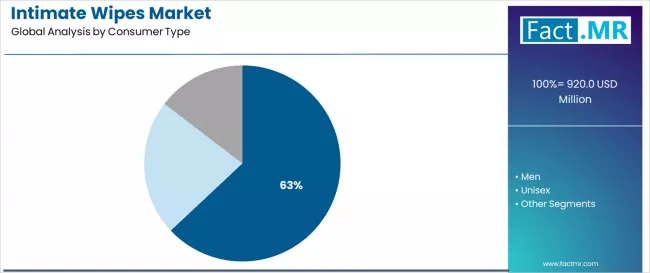
Women's intimate wipes command the leading position in the intimate wipes market with 63% market share through specialized feminine hygiene features, including pH-balanced formulations, gynaecological safety testing, and intimate care optimization that enable women consumers to achieve optimal personal hygiene across diverse daily and menstrual care environments.
The segment benefits from female consumer preference for reliable intimate care products that provide consistent hygiene performance, reduced irritation risk, and personal comfort optimization without requiring significant lifestyle modifications. Advanced formulation features enable dermatological safety, pH balance maintenance, and integration with existing feminine care routines, where safety performance and comfort reliability represent critical consumer requirements.
Women's intimate wipes differentiate through proven safety profiles, consistent comfort characteristics, and integration with comprehensive feminine care systems that enhance personal hygiene effectiveness while maintaining optimal medical safety suitable for diverse intimate and menstrual care applications.
Key market characteristics:
- Advanced formulation designs with optimized pH balance and gynaecological safety capabilities
- Superior comfort effectiveness, enabling 95-98% user satisfaction with consistent hygiene performance
- Feminine care compatibility, including dermatological testing, medical approval, and routine integration for intimate care applications
Men's Personal Care Wipes Show Growing Market Presence
Men's intimate wipes maintain a 24% market position in the intimate wipes market due to their specialized grooming properties and convenience advantages. These products appeal to male consumers requiring efficient personal care with competitive pricing for active lifestyle applications. Market growth is driven by male grooming expansion, emphasizing reliable hygiene solutions and convenience through optimized masculine care formulations.
Unisex and Teen Applications Demonstrate Emerging Growth
Unisex and teen intimate wipes capture 13% market share through specialized hygiene requirements in educational settings, travel applications, and young adult care situations. These consumers demand accessible intimate care products capable of providing effective hygiene while supporting comfort and discretion needs.
By Material Type, the Spunlace Segment Shows Market Leadership
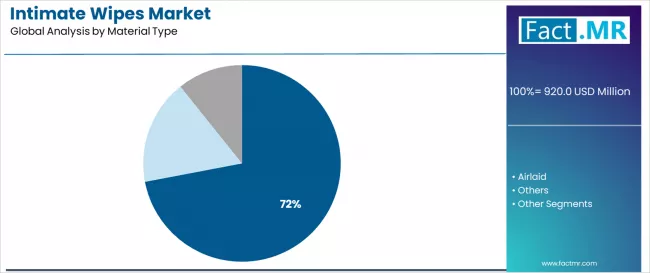
Spunlace material products demonstrate market leadership in the intimate wipes market with 72% share due to widespread adoption of soft-touch technology and increasing focus on consumer comfort, superior absorbency performance, and intimate care material optimization applications that maximize hygiene effectiveness while maintaining skin safety standards.
Spunlace material operators prioritize product softness, safety reliability, and integration with existing manufacturing infrastructure that enables coordinated production across multiple intimate care applications. The segment benefits from substantial material investment and manufacturing programs that emphasize the acquisition of advanced spunlace systems for comfort optimization and safety assurance applications.
Intimate care programs incorporate spunlace materials as standard components for product manufacturing, while consumer preference growth increases demand for soft-touch capabilities that comply with dermatological standards and minimize irritation complexity.
Application dynamics include:
- Strong growth in premium intimate care requiring superior softness capabilities
- Increasing adoption in sensitive skin applications and comfort optimization programs
- Rising integration with advanced manufacturing systems for quality optimization and safety assurance
Airlaid Applications Maintain Specialized Demand
Airlaid material applications capture 18% market share through specialized absorbency requirements in heavy-duty cleaning applications, medical care situations, and institutional hygiene programs. These applications demand robust material systems capable of superior absorption while providing effective cleaning capabilities and operational reliability.
Other Material Applications Show Niche Growth
Other material applications account for 10% market share, including innovative fiber technologies, sustainable material options, and specialized comfort formulations requiring advanced material capabilities for performance optimization and environmental consideration.
By Channel, the Online Segment Shows Fastest Growth
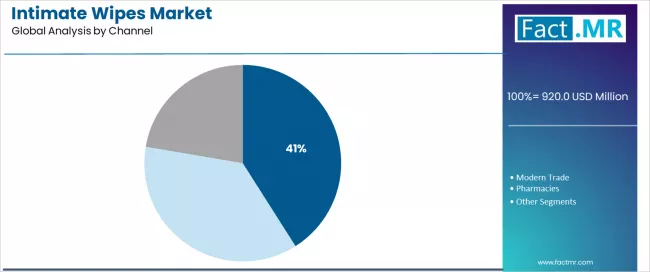
Online distribution channels command 41% market position with strong growth through optimal privacy approach that balances accessibility and discretion for diverse consumer purchasing preferences.
This channel segment provides the ideal combination of privacy protection and product accessibility, meeting requirements for discreet purchasing, subscription convenience, and educational content access without excessive social discomfort or accessibility barriers.
The segment benefits from broad consumer appeal across demographic sectors, established e-commerce platforms, and comprehensive product information that support widespread adoption and purchasing convenience.
By End Use Applications
Daily Hygiene Applications Drive Market Leadership
Daily hygiene applications lead the market with consistent growth, representing the largest end-use segment due to routine personal care needs and hygiene maintenance requirements across diverse consumer demographics and lifestyle situations.
What are the Drivers, Restraints, and Key Trends of the Intimate Wipes Market?
| Category | Factor | Impact | Why It Matters |
|---|---|---|---|
| Driver | Hygiene awareness & feminine care education | ★★★★★ | Growing health consciousness drives demand for specialized intimate care products and professional recommendations |
| Driver | Convenience lifestyle & on-the-go solutions | ★★★★★ | Busy lifestyles require portable hygiene solutions; travel and workplace convenience create consistent demand |
| Driver | Premium product premiumization & natural formulations | ★★★★☆ | Consumer willingness to pay premium for organic, pH-balanced, and dermatologically tested products |
| Restraint | Cultural sensitivity & market acceptance barriers | ★★★★☆ | Traditional taboos and cultural resistance limit market penetration in conservative regions |
| Restraint | Environmental concerns & sustainability pressure | ★★★☆☆ | Growing environmental awareness creates pressure for biodegradable alternatives and packaging reduction |
| Trend | Natural & organic formulation adoption | ★★★★★ | Chemical-free, pH-balanced, and dermatologically approved products gain market preference and medical endorsement |
| Trend | Male grooming market expansion | ★★★★☆ | Men's personal care awareness increases demand for male-specific intimate hygiene products and marketing |
Analysis of the Intimate Wipes Market by Key Country
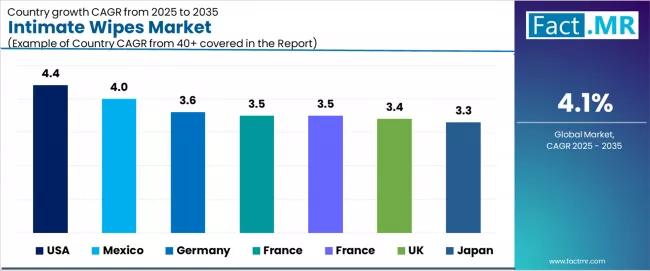
The intimate wipes market demonstrates varied regional dynamics with Growth Leaders including USA (4.4% growth rate) and Mexico (4.0% growth rate) driving expansion through consumer awareness initiatives and retail modernization.
Steady performers encompass Germany (3.6% growth rate), France (3.5% growth rate), and developed regions, benefiting from established personal care industries and premium product adoption. Mature markets feature UK (3.4% growth rate) and Japan (3.3% growth rate), where market saturation and premium positioning support consistent growth patterns.
Regional synthesis reveals North American markets leading adoption through consumer education and retail expansion, while European countries maintain steady growth supported by premium product development and sustainability initiatives. Asian markets show diverse growth driven by cultural acceptance and modernization trends.
| Region/Country | 2025-2035 Growth | How to win | What to watch out |
|---|---|---|---|
| USA | 4.4% | Focus on premium positioning | Market saturation; price competition |
| Germany | 3.6% | Emphasize sustainability | Regulatory complexity; environmental standards |
| UK | 3.4% | Leverage health partnerships | Brexit impacts; supply chain costs |
| France | 3.5% | Target luxury segments | Cultural resistance; premium pricing pressure |
| Japan | 3.3% | Develop travel-size options | Aging demographics; cultural barriers |
| South Korea | 3.5% | Build K-beauty connections | Competitive pressures; brand loyalty |
| Mexico | 4.0% | Expand accessibility | Infrastructure gaps; price sensitivity |
USA Drives Market Leadership
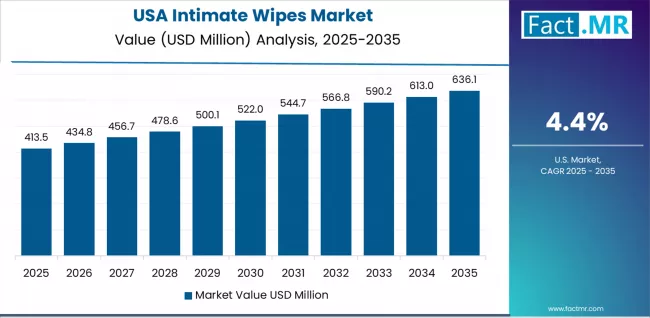
USA establishes market leadership through comprehensive consumer awareness programs and advanced retail distribution, integrating intimate wipes as standard components in personal care and feminine hygiene installations.
The country's 4.4% growth rate reflects consumer education maturity and retail modernization programs that mandate the availability of specialized intimate care products in pharmacy and retail facilities.
Growth concentrates in major metropolitan centers, including New York, California, and Texas, where retail development showcases integrated intimate care sections that appeal to consumers seeking advanced personal hygiene capabilities and convenience applications.
American personal care companies are developing sophisticated intimate wipes solutions that combine domestic consumer insight advantages with advanced formulation features, including dermatological testing and pH-balanced technologies.
Distribution channels through pharmacy chains and retail suppliers expand market access, while healthcare professional endorsement supports adoption across diverse demographic and lifestyle segments.
Strategic Market Indicators:
- Retail facilities leading adoption with 78% availability rate in pharmacy and personal care sectors
- Consumer education programs providing substantial awareness for intimate hygiene advancement
- Local personal care brands capturing 45% market share through consumer insight leadership and premium positioning
- Export market development for advanced intimate care solutions targeting international consumer markets
United Kingdom Shows Premium Market Focus
United Kingdom demonstrates market strength through premium product positioning and healthcare partnership initiatives, maintaining a 3.4% growth rate supported by medical professional endorsement and specialized retail development.
The country leverages its established healthcare system and consumer education programs to drive intimate wipes adoption across feminine care and personal hygiene applications. Major retail chains in London, Manchester, and Birmingham showcase advanced intimate care sections that integrate with pharmaceutical consultation and healthcare guidance programs.
British market dynamics focus on premium intimate wipes that balance medical safety with consumer comfort requirements important to UK healthcare-conscious consumers. The market benefits from NHS healthcare initiatives supporting intimate hygiene education and retail partnerships that create sustained demand for medically approved intimate care products in healthcare and retail applications.
Market Intelligence Brief:
- Healthcare partnerships and retail chains leading growth with emphasis on medical safety and consumer education
- Premium positioning strategies driving higher-value product adoption and medical professional recommendation
- Government healthcare initiatives supporting intimate hygiene awareness and professional guidance programs
- Brexit considerations influencing supply chain strategies and European product alignment
Germany Emerges as Sustainability Leader
In Berlin, Munich, and Hamburg, retail facilities and pharmacy chains are implementing sustainable intimate wipes as standard components for environmental care and consumer health optimization applications, driven by increasing environmental awareness and sustainability modernization programs that emphasize the importance of eco-friendly capabilities.
The market holds a 3.6% growth rate, supported by environmental excellence initiatives and sustainable consumer goods development programs that promote eco-friendly intimate care products for retail and pharmacy facilities. German consumers are adopting intimate wipes that provide consistent hygiene performance and environmental compliance features, particularly appealing in regions where sustainability and health safety represent critical consumer requirements.
Market expansion benefits from established environmental manufacturing capabilities and international sustainability partnerships that enable domestic development of eco-friendly intimate care systems for consumer and healthcare applications. Consumer adoption follows patterns established in sustainable consumer goods, where environmental compliance and safety drive purchasing decisions and lifestyle integration.
Market Intelligence Brief:
- Sustainability and retail segments driving adoption with 52% annual growth in eco-friendly product procurement
- Environmental standardization programs emphasizing intimate care products for sustainability excellence and consumer safety
- Local manufacturing companies partnering with international providers for sustainable technology development
- Retail facilities implementing eco-friendly intimate care products for consumer optimization and environmental management
France Maintains Luxury Market Position
France's intimate wipes market demonstrates sophisticated consumer preferences with documented effectiveness in luxury personal care applications through integration with existing beauty systems and healthcare infrastructure. The country leverages cosmetic expertise and luxury product manufacturing integration to maintain a 3.5% growth rate. Beauty centers, including Paris, Lyon, and Nice, showcase premium installations where intimate wipes integrate with comprehensive personal care platforms and beauty management systems to optimize feminine hygiene operations and luxury effectiveness.
French personal care companies prioritize product innovation and EU regulatory compliance in intimate wipes development, creating demand for luxury systems with sophisticated features, including beauty integration and premium formulation systems. The market benefits from established cosmetic infrastructure and investment in luxury product advancement that provides long-term consumer benefits and compliance with international beauty standards.
Strategic Market Considerations:
- Innovation focus on EU beauty standardization and luxury positioning, driving premium segment growth
- Cosmetic partnerships providing enhanced formulation capabilities and faster product development cycles
- Technology collaboration between French companies and international beauty organizations
- Beauty training programs expanding intimate care integration in personal care scenarios
Japan Shows Precision Care Focus
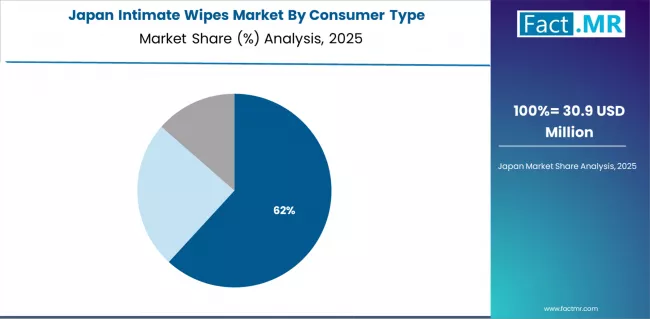
Japan's market expansion benefits from precision personal care demand, including advanced hygiene solutions in Tokyo and Osaka, retail facility modernization, and government health programs that increasingly incorporate intimate wipes for consumer care optimization applications.
The country maintains a 3.3% growth rate, driven by consumer technology advancement and increasing recognition of intimate care benefits, including precise hygiene control and convenience enhancement.
Market dynamics focus on high-precision intimate care solutions that balance advanced performance with quality considerations important to Japanese consumers. Growing personal care industrialization creates continued demand for sophisticated intimate wipes in retail infrastructure and consumer care modernization projects.
Market Intelligence Brief:
- Consumer care and retail segments leading growth with focus on precision hygiene and convenience optimization applications
- Regional consumer requirements driving diverse product portfolio from basic intimate care to advanced hygiene systems
- Technology advancement emphasis on precision formulation and quality control systems
- Government health initiatives supporting domestic consumer care capabilities and international competitiveness
South Korea Drives K-Beauty Integration
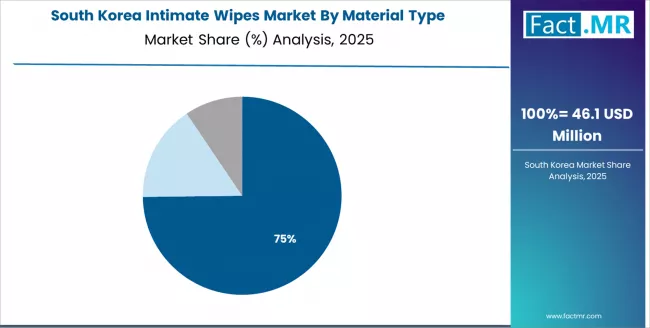
South Korea establishes strong market position through K-beauty integration programs and personal care innovation expansion, integrating advanced intimate wipes as standard components for beauty optimization and consumer care applications.
The country's 3.5% growth rate reflects government beauty industry initiatives and consumer modernization programs that emphasize advanced intimate care systems for beauty enhancement and personal hygiene.
Growth concentrates in major beauty centers, including Seoul and Busan, where cosmetic development showcases integrated intimate care systems that appeal to consumers seeking comprehensive beauty capabilities and hygiene compliance applications.
Korean beauty companies are developing innovative intimate wipes solutions that combine domestic beauty innovation advantages with advanced care features, including K-beauty integration and enhanced consumer experience capabilities. Distribution channels through beauty retailers and cosmetic suppliers expand market access, while government support for beauty industry development supports adoption across consumer care and beauty segments.
Strategic Market Indicators:
- Beauty integration facilities leading adoption with 68% deployment rate in cosmetic and personal care sectors
- Government beauty programs providing substantial funding for domestic consumer care advancement
- Local beauty companies capturing significant market share through innovation leadership and K-beauty integration expertise
- Export market development for advanced intimate care solutions targeting international beauty markets
Mexico Shows Regional Expansion
Mexico's market expansion benefits from growing consumer awareness, including personal care development in Mexico City and Guadalajara, retail facility upgrades, and government health programs that increasingly incorporate intimate wipes solutions for hygiene optimization applications.
The country maintains a 4.0% growth rate, driven by retail industry growth and increasing adoption of personal care solutions, including advanced intimate hygiene and consumer convenience enhancement.
Market dynamics focus on accessible intimate care solutions that balance performance with affordability considerations important to Mexican consumers. Growing retail modernization creates continued demand for reliable intimate wipes in facility expansion and consumer care improvement projects.
Strategic Market Considerations:
- Retail expansion segments leading growth with focus on accessibility and consumer education applications
- Regional consumer requirements driving diverse product portfolio from basic hygiene to premium intimate care systems
- Import considerations balanced by potential domestic retail partnerships with international personal care providers
- Government health initiatives influencing consumer education standards and hygiene requirements
Europe Market Split by Country
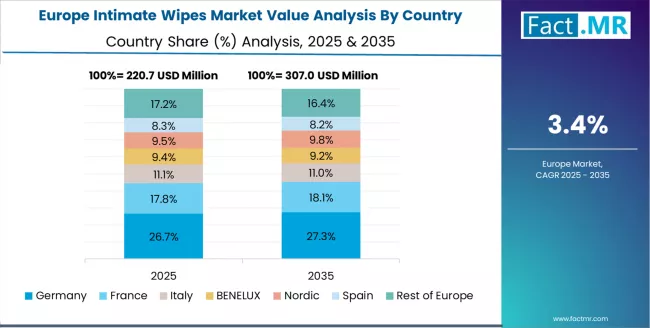
The Europe intimate wipes market is projected to grow from USD 285.0 million in 2025 to USD 420.0 million by 2035, registering a CAGR of 3.9% over the forecast period. Germany is expected to maintain its leadership position with a 26.8% market share in 2025, supported by advanced sustainability infrastructure and major retail centers.
United Kingdom follows with a 23.2% share in 2025, driven by comprehensive healthcare programs and premium product positioning initiatives. France holds a 21.4% share, supported by specialized luxury applications and cosmetic industry integration.
Italy commands a 15.1% share, while Spain accounts for 8.9% in 2025. The Rest of Western Europe region is anticipated to gain momentum, holding 4.6% in 2025, increasing to 5.2% by 2035, attributed to rising consumer awareness in Nordic countries and emerging retail facilities implementing intimate care modernization programs.
Women's Products Dominate Consumer Preference in Germany
In Germany, the intimate wipes market prioritizes women's products, which capture the dominant 63% share of retail and pharmacy installations due to their specialized features, including precision feminine hygiene formulation and seamless integration with existing healthcare infrastructure.
German consumer operators emphasize safety, environmental compliance, and long-term health excellence, creating demand for women's intimate wipes that provide consistent hygiene capabilities and adaptive performance based on medical requirements and sustainability conditions.
Other consumer segments maintain secondary positions primarily in specialized applications and niche markets where comprehensive care functionality meets consumer requirements without compromising environmental compliance.
Market Characteristics:
- Premium focus on women's intimate wipes with advanced pH-balance algorithms and precision care capabilities
- Integration requirements with existing healthcare platforms and environmental management systems
- Emphasis on sustainability compliance and long-term health safety in intimate care applications
Personal Care Companies Lead Product Development in United Kingdom
In United Kingdom, the market structure favors international personal care companies, including Kimberly-Clark, P&G, and Edgewell, which maintain dominant positions through comprehensive product portfolios and established retail networks supporting both premium and accessible intimate care installations.
These providers offer integrated solutions combining advanced intimate wipes with professional healthcare consultation and ongoing consumer education that appeal to consumers seeking reliable personal hygiene systems.
Local healthcare contractors and specialty retailers capture a moderate market share by providing localized care capabilities and competitive pricing for standard consumer installations, while domestic companies focus on specialized applications and premium solutions tailored to British healthcare characteristics.
Channel Insights:
- International personal care brands maintaining premium market positioning through advanced product offerings
- Local retail service networks expanding to support growing demand for professional consultation and consumer education
- Healthcare integration capabilities becoming a key differentiator for pharmacy-wide and healthcare platform applications
Competitive Landscape of the Intimate Wipes Market
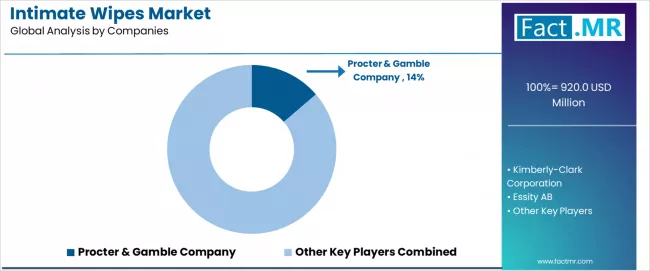
- Structure: ~15-20 credible players; top 3-5 hold ~50-55% by revenue.
- Leadership is maintained through: brand trust, distribution reach, and consumer education programs.
- What's commoditizing: basic wet wipe formulations and standard packaging solutions.
- Margin Opportunities: premium formulations, subscription services, and medical professional partnerships.
| Stakeholder | What they actually control | Typical strengths | Typical blind spots |
|---|---|---|---|
| Global personal care giants | Distribution networks, marketing budgets, R&D capabilities | Broad availability, consumer trust, proven safety | Innovation speed; niche market responsiveness |
| Premium/organic specialists | Natural formulations, medical partnerships, sustainability focus | Product differentiation, health positioning | Scale limitations; cost pressures |
| Regional/local brands | Local preferences, competitive pricing, rapid response | Market proximity, cultural understanding | Brand recognition; distribution limitations |
| Private label manufacturers | Cost efficiency, retailer relationships, volume production | Price competitiveness, retailer integration | Brand building; innovation investment |
Key Players in the Intimate Wipes Market
- Procter & Gamble Company
- Kimberly-Clark Corporation
- Essity AB
- Unicharm Corporation
- Johnson & Johnson
- Nice-Pak Products, Inc.
- Edgewell Personal Care Company
- Kao Corporation
- Ontex Group
- Bodyform/Libresse (part of Essity)
Scope of the Report
| Item | Value |
|---|---|
| Quantitative Units | USD 920.0 million |
| Consumer Type | Women, Men, Unisex/Teens |
| Material Type | Spunlace, Airlaid, Others |
| Channel | Online, Modern Trade, Pharmacies |
| End Use | Daily Hygiene, Menstrual Care, Travel Convenience, Medical Applications |
| Regions Covered | North America, Western Europe, East Asia, South Asia Pacific, Latin America, Middle East & Africa |
| Countries Covered | United States, Germany, United Kingdom, France, Japan, South Korea, Mexico, Canada, Italy, and 25+ additional countries |
| Key Companies Profiled | Kimberly-Clark, P&G, Edgewell, Essity, Unicharm, Johnson & Johnson, Nice-Pak, Bodyform/Libresse, Kao, Ontex |
| Additional Attributes | Dollar sales by consumer type and material categories, regional adoption trends across North America, Western Europe, and East Asia, competitive landscape with personal care manufacturers and retail distributors, consumer preferences for hygiene optimization and comfort reliability, integration with feminine care platforms and healthcare systems, innovations in formulation technology and safety enhancement, and development of sustainable intimate care solutions with enhanced performance and environmental optimization capabilities. |
Intimate Wipes Market by Segments
-
Consumer Type :
- Women
- Men
- Unisex/Teens
-
Material Type :
- Spunlace
- Airlaid
- Others
-
Channel :
- Online
- Modern Trade
- Pharmacies
-
End Use :
- Daily Hygiene
- Menstrual Care
- Travel Convenience
- Medical Applications
-
Region :
- North America
- United States
- Canada
- Mexico
- Western Europe
- Germany
- United Kingdom
- France
- Italy
- Spain
- Nordic
- BENELUX
- Rest of Western Europe
- East Asia
- China
- Japan
- South Korea
- South Asia Pacific
- India
- ASEAN
- Australia & New Zealand
- Rest of South Asia Pacific
- Latin America
- Brazil
- Chile
- Rest of Latin America
- Middle East & Africa
- Kingdom of Saudi Arabia
- Other GCC Countries
- Turkey
- South Africa
- Other African Union
- Rest of Middle East & Africa
- North America
Table of Content
- Executive Summary
- Global Market Outlook
- Demand to side Trends
- Supply to side Trends
- Technology Roadmap Analysis
- Analysis and Recommendations
- Market Overview
- Market Coverage / Taxonomy
- Market Definition / Scope / Limitations
- Market Background
- Market Dynamics
- Drivers
- Restraints
- Opportunity
- Trends
- Scenario Forecast
- Demand in Optimistic Scenario
- Demand in Likely Scenario
- Demand in Conservative Scenario
- Opportunity Map Analysis
- Product Life Cycle Analysis
- Supply Chain Analysis
- Investment Feasibility Matrix
- Value Chain Analysis
- PESTLE and Porter’s Analysis
- Regulatory Landscape
- Regional Parent Market Outlook
- Production and Consumption Statistics
- Import and Export Statistics
- Market Dynamics
- Global Market Analysis 2020 to 2024 and Forecast, 2025 to 2035
- Historical Market Size Value (USD Million) Analysis, 2020 to 2024
- Current and Future Market Size Value (USD Million) Projections, 2025 to 2035
- Y to o to Y Growth Trend Analysis
- Absolute $ Opportunity Analysis
- Global Market Pricing Analysis 2020 to 2024 and Forecast 2025 to 2035
- Global Market Analysis 2020 to 2024 and Forecast 2025 to 2035, By Consumer Type
- Introduction / Key Findings
- Historical Market Size Value (USD Million) Analysis By Consumer Type , 2020 to 2024
- Current and Future Market Size Value (USD Million) Analysis and Forecast By Consumer Type , 2025 to 2035
- Women
- Men
- Unisex
- Y to o to Y Growth Trend Analysis By Consumer Type , 2020 to 2024
- Absolute $ Opportunity Analysis By Consumer Type , 2025 to 2035
- Global Market Analysis 2020 to 2024 and Forecast 2025 to 2035, By Material Type
- Introduction / Key Findings
- Historical Market Size Value (USD Million) Analysis By Material Type, 2020 to 2024
- Current and Future Market Size Value (USD Million) Analysis and Forecast By Material Type, 2025 to 2035
- Spunlace
- Airlaid
- Others
- Y to o to Y Growth Trend Analysis By Material Type, 2020 to 2024
- Absolute $ Opportunity Analysis By Material Type, 2025 to 2035
- Global Market Analysis 2020 to 2024 and Forecast 2025 to 2035, By Channel
- Introduction / Key Findings
- Historical Market Size Value (USD Million) Analysis By Channel, 2020 to 2024
- Current and Future Market Size Value (USD Million) Analysis and Forecast By Channel, 2025 to 2035
- Online
- Modern Trade
- Pharmacies
- Y to o to Y Growth Trend Analysis By Channel, 2020 to 2024
- Absolute $ Opportunity Analysis By Channel, 2025 to 2035
- Global Market Analysis 2020 to 2024 and Forecast 2025 to 2035, By Region
- Introduction
- Historical Market Size Value (USD Million) Analysis By Region, 2020 to 2024
- Current Market Size Value (USD Million) Analysis and Forecast By Region, 2025 to 2035
- North America
- Latin America
- Western Europe
- Eastern Europe
- East Asia
- South Asia and Pacific
- Middle East & Africa
- Market Attractiveness Analysis By Region
- North America Market Analysis 2020 to 2024 and Forecast 2025 to 2035, By Country
- Historical Market Size Value (USD Million) Trend Analysis By Market Taxonomy, 2020 to 2024
- Market Size Value (USD Million) Forecast By Market Taxonomy, 2025 to 2035
- By Country
- USA
- Canada
- Mexico
- By Consumer Type
- By Material Type
- By Channel
- By Country
- Market Attractiveness Analysis
- By Country
- By Consumer Type
- By Material Type
- By Channel
- Key Takeaways
- Latin America Market Analysis 2020 to 2024 and Forecast 2025 to 2035, By Country
- Historical Market Size Value (USD Million) Trend Analysis By Market Taxonomy, 2020 to 2024
- Market Size Value (USD Million) Forecast By Market Taxonomy, 2025 to 2035
- By Country
- Brazil
- Chile
- Rest of Latin America
- By Consumer Type
- By Material Type
- By Channel
- By Country
- Market Attractiveness Analysis
- By Country
- By Consumer Type
- By Material Type
- By Channel
- Key Takeaways
- Western Europe Market Analysis 2020 to 2024 and Forecast 2025 to 2035, By Country
- Historical Market Size Value (USD Million) Trend Analysis By Market Taxonomy, 2020 to 2024
- Market Size Value (USD Million) Forecast By Market Taxonomy, 2025 to 2035
- By Country
- Germany
- UK
- Italy
- Spain
- France
- Nordic
- BENELUX
- Rest of Western Europe
- By Consumer Type
- By Material Type
- By Channel
- By Country
- Market Attractiveness Analysis
- By Country
- By Consumer Type
- By Material Type
- By Channel
- Key Takeaways
- Eastern Europe Market Analysis 2020 to 2024 and Forecast 2025 to 2035, By Country
- Historical Market Size Value (USD Million) Trend Analysis By Market Taxonomy, 2020 to 2024
- Market Size Value (USD Million) Forecast By Market Taxonomy, 2025 to 2035
- By Country
- Russia
- Poland
- Hungary
- Balkan & Baltic
- Rest of Eastern Europe
- By Consumer Type
- By Material Type
- By Channel
- By Country
- Market Attractiveness Analysis
- By Country
- By Consumer Type
- By Material Type
- By Channel
- Key Takeaways
- East Asia Market Analysis 2020 to 2024 and Forecast 2025 to 2035, By Country
- Historical Market Size Value (USD Million) Trend Analysis By Market Taxonomy, 2020 to 2024
- Market Size Value (USD Million) Forecast By Market Taxonomy, 2025 to 2035
- By Country
- China
- Japan
- South Korea
- By Consumer Type
- By Material Type
- By Channel
- By Country
- Market Attractiveness Analysis
- By Country
- By Consumer Type
- By Material Type
- By Channel
- Key Takeaways
- South Asia and Pacific Market Analysis 2020 to 2024 and Forecast 2025 to 2035, By Country
- Historical Market Size Value (USD Million) Trend Analysis By Market Taxonomy, 2020 to 2024
- Market Size Value (USD Million) Forecast By Market Taxonomy, 2025 to 2035
- By Country
- India
- ASEAN
- Australia & New Zealand
- Rest of South Asia and Pacific
- By Consumer Type
- By Material Type
- By Channel
- By Country
- Market Attractiveness Analysis
- By Country
- By Consumer Type
- By Material Type
- By Channel
- Key Takeaways
- Middle East & Africa Market Analysis 2020 to 2024 and Forecast 2025 to 2035, By Country
- Historical Market Size Value (USD Million) Trend Analysis By Market Taxonomy, 2020 to 2024
- Market Size Value (USD Million) Forecast By Market Taxonomy, 2025 to 2035
- By Country
- Kingdom of Saudi Arabia
- Other GCC Countries
- Turkiye
- South Africa
- Other African Union
- Rest of Middle East & Africa
- By Consumer Type
- By Material Type
- By Channel
- By Country
- Market Attractiveness Analysis
- By Country
- By Consumer Type
- By Material Type
- By Channel
- Key Takeaways
- Key Countries Market Analysis
- USA
- Pricing Analysis
- Market Share Analysis, 2024
- By Consumer Type
- By Material Type
- By Channel
- Canada
- Pricing Analysis
- Market Share Analysis, 2024
- By Consumer Type
- By Material Type
- By Channel
- Mexico
- Pricing Analysis
- Market Share Analysis, 2024
- By Consumer Type
- By Material Type
- By Channel
- Brazil
- Pricing Analysis
- Market Share Analysis, 2024
- By Consumer Type
- By Material Type
- By Channel
- Chile
- Pricing Analysis
- Market Share Analysis, 2024
- By Consumer Type
- By Material Type
- By Channel
- Germany
- Pricing Analysis
- Market Share Analysis, 2024
- By Consumer Type
- By Material Type
- By Channel
- UK
- Pricing Analysis
- Market Share Analysis, 2024
- By Consumer Type
- By Material Type
- By Channel
- Italy
- Pricing Analysis
- Market Share Analysis, 2024
- By Consumer Type
- By Material Type
- By Channel
- Spain
- Pricing Analysis
- Market Share Analysis, 2024
- By Consumer Type
- By Material Type
- By Channel
- France
- Pricing Analysis
- Market Share Analysis, 2024
- By Consumer Type
- By Material Type
- By Channel
- India
- Pricing Analysis
- Market Share Analysis, 2024
- By Consumer Type
- By Material Type
- By Channel
- ASEAN
- Pricing Analysis
- Market Share Analysis, 2024
- By Consumer Type
- By Material Type
- By Channel
- Australia & New Zealand
- Pricing Analysis
- Market Share Analysis, 2024
- By Consumer Type
- By Material Type
- By Channel
- China
- Pricing Analysis
- Market Share Analysis, 2024
- By Consumer Type
- By Material Type
- By Channel
- Japan
- Pricing Analysis
- Market Share Analysis, 2024
- By Consumer Type
- By Material Type
- By Channel
- South Korea
- Pricing Analysis
- Market Share Analysis, 2024
- By Consumer Type
- By Material Type
- By Channel
- Russia
- Pricing Analysis
- Market Share Analysis, 2024
- By Consumer Type
- By Material Type
- By Channel
- Poland
- Pricing Analysis
- Market Share Analysis, 2024
- By Consumer Type
- By Material Type
- By Channel
- Hungary
- Pricing Analysis
- Market Share Analysis, 2024
- By Consumer Type
- By Material Type
- By Channel
- Kingdom of Saudi Arabia
- Pricing Analysis
- Market Share Analysis, 2024
- By Consumer Type
- By Material Type
- By Channel
- Turkiye
- Pricing Analysis
- Market Share Analysis, 2024
- By Consumer Type
- By Material Type
- By Channel
- South Africa
- Pricing Analysis
- Market Share Analysis, 2024
- By Consumer Type
- By Material Type
- By Channel
- USA
- Market Structure Analysis
- Competition Dashboard
- Competition Benchmarking
- Market Share Analysis of Top Players
- By Regional
- By Consumer Type
- By Material Type
- By Channel
- Competition Analysis
- Competition Deep Dive
- Procter & Gamble Company
- Overview
- Product Portfolio
- Profitability by Market Segments (Product/Age /Sales Channel/Region)
- Sales Footprint
- Strategy Overview
- Marketing Strategy
- Product Strategy
- Channel Strategy
- Kimberly-Clark Corporation
- Essity AB
- Unicharm Corporation
- Johnson & Johnson
- Nice-Pak Products, Inc.
- Edgewell Personal Care Company
- Kao Corporation
- Ontex Group
- Bodyform/Libresse (part of Essity)
- Procter & Gamble Company
- Competition Deep Dive
- Assumptions & Acronyms Used
- Research Methodology
List Of Table
- Table 1: Global Market Value (USD Million) Forecast by Region, 2020 to 2035
- Table 2: Global Market Value (USD Million) Forecast by Consumer Type , 2020 to 2035
- Table 3: Global Market Value (USD Million) Forecast by Material Type, 2020 to 2035
- Table 4: Global Market Value (USD Million) Forecast by Channel, 2020 to 2035
- Table 5: North America Market Value (USD Million) Forecast by Country, 2020 to 2035
- Table 6: North America Market Value (USD Million) Forecast by Consumer Type , 2020 to 2035
- Table 7: North America Market Value (USD Million) Forecast by Material Type, 2020 to 2035
- Table 8: North America Market Value (USD Million) Forecast by Channel, 2020 to 2035
- Table 9: Latin America Market Value (USD Million) Forecast by Country, 2020 to 2035
- Table 10: Latin America Market Value (USD Million) Forecast by Consumer Type , 2020 to 2035
- Table 11: Latin America Market Value (USD Million) Forecast by Material Type, 2020 to 2035
- Table 12: Latin America Market Value (USD Million) Forecast by Channel, 2020 to 2035
- Table 13: Western Europe Market Value (USD Million) Forecast by Country, 2020 to 2035
- Table 14: Western Europe Market Value (USD Million) Forecast by Consumer Type , 2020 to 2035
- Table 15: Western Europe Market Value (USD Million) Forecast by Material Type, 2020 to 2035
- Table 16: Western Europe Market Value (USD Million) Forecast by Channel, 2020 to 2035
- Table 17: Eastern Europe Market Value (USD Million) Forecast by Country, 2020 to 2035
- Table 18: Eastern Europe Market Value (USD Million) Forecast by Consumer Type , 2020 to 2035
- Table 19: Eastern Europe Market Value (USD Million) Forecast by Material Type, 2020 to 2035
- Table 20: Eastern Europe Market Value (USD Million) Forecast by Channel, 2020 to 2035
- Table 21: East Asia Market Value (USD Million) Forecast by Country, 2020 to 2035
- Table 22: East Asia Market Value (USD Million) Forecast by Consumer Type , 2020 to 2035
- Table 23: East Asia Market Value (USD Million) Forecast by Material Type, 2020 to 2035
- Table 24: East Asia Market Value (USD Million) Forecast by Channel, 2020 to 2035
- Table 25: South Asia and Pacific Market Value (USD Million) Forecast by Country, 2020 to 2035
- Table 26: South Asia and Pacific Market Value (USD Million) Forecast by Consumer Type , 2020 to 2035
- Table 27: South Asia and Pacific Market Value (USD Million) Forecast by Material Type, 2020 to 2035
- Table 28: South Asia and Pacific Market Value (USD Million) Forecast by Channel, 2020 to 2035
- Table 29: Middle East & Africa Market Value (USD Million) Forecast by Country, 2020 to 2035
- Table 30: Middle East & Africa Market Value (USD Million) Forecast by Consumer Type , 2020 to 2035
- Table 31: Middle East & Africa Market Value (USD Million) Forecast by Material Type, 2020 to 2035
- Table 32: Middle East & Africa Market Value (USD Million) Forecast by Channel, 2020 to 2035
List Of Figures
- Figure 1: Global Market Pricing Analysis
- Figure 2: Global Market Value (USD Million) Forecast 2020-2035
- Figure 3: Global Market Value Share and BPS Analysis by Consumer Type , 2025 and 2035
- Figure 4: Global Market Y to o to Y Growth Comparison by Consumer Type , 2025-2035
- Figure 5: Global Market Attractiveness Analysis by Consumer Type
- Figure 6: Global Market Value Share and BPS Analysis by Material Type, 2025 and 2035
- Figure 7: Global Market Y to o to Y Growth Comparison by Material Type, 2025-2035
- Figure 8: Global Market Attractiveness Analysis by Material Type
- Figure 9: Global Market Value Share and BPS Analysis by Channel, 2025 and 2035
- Figure 10: Global Market Y to o to Y Growth Comparison by Channel, 2025-2035
- Figure 11: Global Market Attractiveness Analysis by Channel
- Figure 12: Global Market Value (USD Million) Share and BPS Analysis by Region, 2025 and 2035
- Figure 13: Global Market Y to o to Y Growth Comparison by Region, 2025-2035
- Figure 14: Global Market Attractiveness Analysis by Region
- Figure 15: North America Market Incremental Dollar Opportunity, 2025-2035
- Figure 16: Latin America Market Incremental Dollar Opportunity, 2025-2035
- Figure 17: Western Europe Market Incremental Dollar Opportunity, 2025-2035
- Figure 18: Eastern Europe Market Incremental Dollar Opportunity, 2025-2035
- Figure 19: East Asia Market Incremental Dollar Opportunity, 2025-2035
- Figure 20: South Asia and Pacific Market Incremental Dollar Opportunity, 2025-2035
- Figure 21: Middle East & Africa Market Incremental Dollar Opportunity, 2025-2035
- Figure 22: North America Market Value Share and BPS Analysis by Country, 2025 and 2035
- Figure 23: North America Market Value Share and BPS Analysis by Consumer Type , 2025 and 2035
- Figure 24: North America Market Y to o to Y Growth Comparison by Consumer Type , 2025-2035
- Figure 25: North America Market Attractiveness Analysis by Consumer Type
- Figure 26: North America Market Value Share and BPS Analysis by Material Type, 2025 and 2035
- Figure 27: North America Market Y to o to Y Growth Comparison by Material Type, 2025-2035
- Figure 28: North America Market Attractiveness Analysis by Material Type
- Figure 29: North America Market Value Share and BPS Analysis by Channel, 2025 and 2035
- Figure 30: North America Market Y to o to Y Growth Comparison by Channel, 2025-2035
- Figure 31: North America Market Attractiveness Analysis by Channel
- Figure 32: Latin America Market Value Share and BPS Analysis by Country, 2025 and 2035
- Figure 33: Latin America Market Value Share and BPS Analysis by Consumer Type , 2025 and 2035
- Figure 34: Latin America Market Y to o to Y Growth Comparison by Consumer Type , 2025-2035
- Figure 35: Latin America Market Attractiveness Analysis by Consumer Type
- Figure 36: Latin America Market Value Share and BPS Analysis by Material Type, 2025 and 2035
- Figure 37: Latin America Market Y to o to Y Growth Comparison by Material Type, 2025-2035
- Figure 38: Latin America Market Attractiveness Analysis by Material Type
- Figure 39: Latin America Market Value Share and BPS Analysis by Channel, 2025 and 2035
- Figure 40: Latin America Market Y to o to Y Growth Comparison by Channel, 2025-2035
- Figure 41: Latin America Market Attractiveness Analysis by Channel
- Figure 42: Western Europe Market Value Share and BPS Analysis by Country, 2025 and 2035
- Figure 43: Western Europe Market Value Share and BPS Analysis by Consumer Type , 2025 and 2035
- Figure 44: Western Europe Market Y to o to Y Growth Comparison by Consumer Type , 2025-2035
- Figure 45: Western Europe Market Attractiveness Analysis by Consumer Type
- Figure 46: Western Europe Market Value Share and BPS Analysis by Material Type, 2025 and 2035
- Figure 47: Western Europe Market Y to o to Y Growth Comparison by Material Type, 2025-2035
- Figure 48: Western Europe Market Attractiveness Analysis by Material Type
- Figure 49: Western Europe Market Value Share and BPS Analysis by Channel, 2025 and 2035
- Figure 50: Western Europe Market Y to o to Y Growth Comparison by Channel, 2025-2035
- Figure 51: Western Europe Market Attractiveness Analysis by Channel
- Figure 52: Eastern Europe Market Value Share and BPS Analysis by Country, 2025 and 2035
- Figure 53: Eastern Europe Market Value Share and BPS Analysis by Consumer Type , 2025 and 2035
- Figure 54: Eastern Europe Market Y to o to Y Growth Comparison by Consumer Type , 2025-2035
- Figure 55: Eastern Europe Market Attractiveness Analysis by Consumer Type
- Figure 56: Eastern Europe Market Value Share and BPS Analysis by Material Type, 2025 and 2035
- Figure 57: Eastern Europe Market Y to o to Y Growth Comparison by Material Type, 2025-2035
- Figure 58: Eastern Europe Market Attractiveness Analysis by Material Type
- Figure 59: Eastern Europe Market Value Share and BPS Analysis by Channel, 2025 and 2035
- Figure 60: Eastern Europe Market Y to o to Y Growth Comparison by Channel, 2025-2035
- Figure 61: Eastern Europe Market Attractiveness Analysis by Channel
- Figure 62: East Asia Market Value Share and BPS Analysis by Country, 2025 and 2035
- Figure 63: East Asia Market Value Share and BPS Analysis by Consumer Type , 2025 and 2035
- Figure 64: East Asia Market Y to o to Y Growth Comparison by Consumer Type , 2025-2035
- Figure 65: East Asia Market Attractiveness Analysis by Consumer Type
- Figure 66: East Asia Market Value Share and BPS Analysis by Material Type, 2025 and 2035
- Figure 67: East Asia Market Y to o to Y Growth Comparison by Material Type, 2025-2035
- Figure 68: East Asia Market Attractiveness Analysis by Material Type
- Figure 69: East Asia Market Value Share and BPS Analysis by Channel, 2025 and 2035
- Figure 70: East Asia Market Y to o to Y Growth Comparison by Channel, 2025-2035
- Figure 71: East Asia Market Attractiveness Analysis by Channel
- Figure 72: South Asia and Pacific Market Value Share and BPS Analysis by Country, 2025 and 2035
- Figure 73: South Asia and Pacific Market Value Share and BPS Analysis by Consumer Type , 2025 and 2035
- Figure 74: South Asia and Pacific Market Y to o to Y Growth Comparison by Consumer Type , 2025-2035
- Figure 75: South Asia and Pacific Market Attractiveness Analysis by Consumer Type
- Figure 76: South Asia and Pacific Market Value Share and BPS Analysis by Material Type, 2025 and 2035
- Figure 77: South Asia and Pacific Market Y to o to Y Growth Comparison by Material Type, 2025-2035
- Figure 78: South Asia and Pacific Market Attractiveness Analysis by Material Type
- Figure 79: South Asia and Pacific Market Value Share and BPS Analysis by Channel, 2025 and 2035
- Figure 80: South Asia and Pacific Market Y to o to Y Growth Comparison by Channel, 2025-2035
- Figure 81: South Asia and Pacific Market Attractiveness Analysis by Channel
- Figure 82: Middle East & Africa Market Value Share and BPS Analysis by Country, 2025 and 2035
- Figure 83: Middle East & Africa Market Value Share and BPS Analysis by Consumer Type , 2025 and 2035
- Figure 84: Middle East & Africa Market Y to o to Y Growth Comparison by Consumer Type , 2025-2035
- Figure 85: Middle East & Africa Market Attractiveness Analysis by Consumer Type
- Figure 86: Middle East & Africa Market Value Share and BPS Analysis by Material Type, 2025 and 2035
- Figure 87: Middle East & Africa Market Y to o to Y Growth Comparison by Material Type, 2025-2035
- Figure 88: Middle East & Africa Market Attractiveness Analysis by Material Type
- Figure 89: Middle East & Africa Market Value Share and BPS Analysis by Channel, 2025 and 2035
- Figure 90: Middle East & Africa Market Y to o to Y Growth Comparison by Channel, 2025-2035
- Figure 91: Middle East & Africa Market Attractiveness Analysis by Channel
- Figure 92: Global Market - Tier Structure Analysis
- Figure 93: Global Market - Company Share Analysis
- FAQs -
How big is the intimate wipes market in 2025?
The global intimate wipes market is estimated to be valued at USD 920.0 million in 2025.
What will be the size of intimate wipes market in 2035?
The market size for the intimate wipes market is projected to reach USD 1,375.0 million by 2035.
How much will be the intimate wipes market growth between 2025 and 2035?
The intimate wipes market is expected to grow at a 4.1% CAGR between 2025 and 2035.
What are the key product types in the intimate wipes market?
The key product types in intimate wipes market are women, men and unisex.
Which material type segment to contribute significant share in the intimate wipes market in 2025?
In terms of material type, spunlace segment to command 72.0% share in the intimate wipes market in 2025.